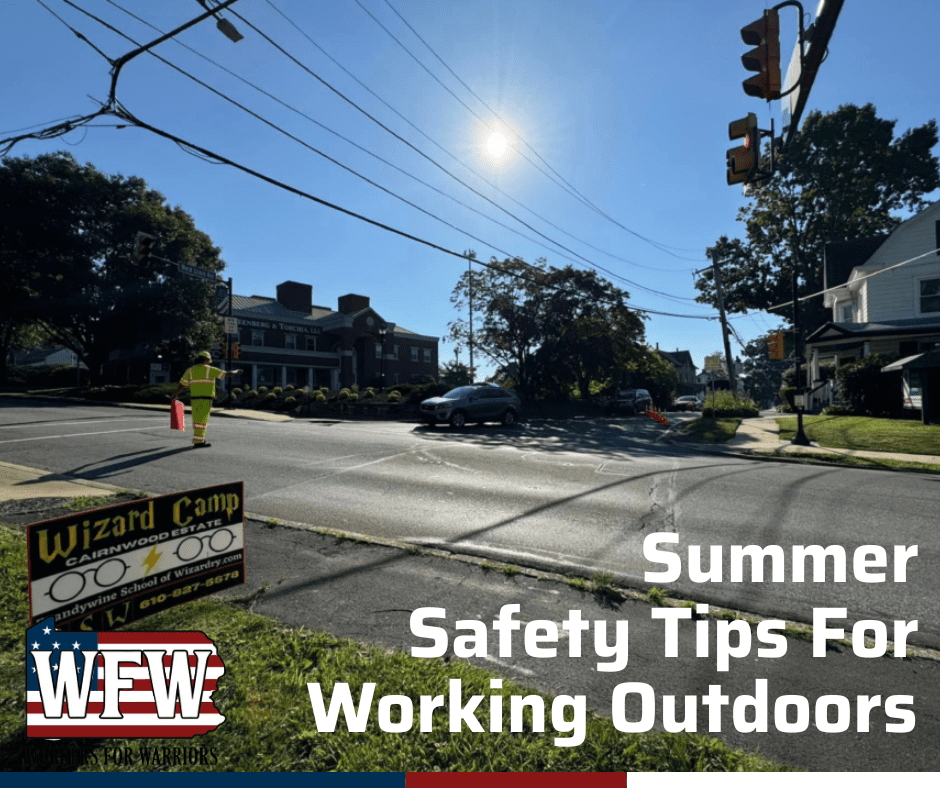Workers For Warrior’s crews work outside in all types of weather, including when the summer heat arrives. We take the safety of our team seriously, that’s why we’re sharing some essential summer safety tips to keep everyone cool and healthy on the job. In this blog, we’ll explore summer safety tips for working outdoors in extreme heat.
Working outdoors in extreme heat presents significant challenges and risks to health and safety, but with the right precautions, it doesn’t have to be a barrier. The dangers of heat exhaustion and heat stroke are real for anyone exposed to high temperatures for extended periods. However, by understanding the risks and taking steps to protect yourself, you can prevent heat-related illnesses and ensure a safe and productive day.
Note: The following information regarding the summer safety tips for working outdoors in extreme heat is not meant to be medical advice. In all cases, get medical advice from a specialist and dial 911.
9 Essential Summer Safety Tips for Working Outdoors in Extreme Heat
1. Know the Signs of Heat Illness
Summer’s heat can overwhelm even with precautions in place. Here’s how workers and employers can stay safe outdoors:
Be aware of heat illness signs, according to OSHA):
|
If someone shows symptoms:
|
Remember, early action is key!
2. Staying Hydrated
Proper hydration is crucial for regulating body temperature and avoiding heat-related health issues. Drinking water regularly, even when not thirsty, helps maintain your body’s balance and temperature.
Here are some additional hydration tips:
- Avoid caffeine and alcohol as they can increase dehydration.
- Opt for electrolyte-replenishing drinks during prolonged physical activities.
Staying hydrated keeps you cool, improves focus, and allows your body to function at its best throughout the workday.
3. Apply Sunscreen
Protecting your skin from UV rays is crucial for preventing sunburn, premature aging, and skin cancer. To protect your skin, use a broad-spectrum sunscreen with at least SPF 30, apply it generously to all exposed areas—including your ears, neck, and hands—and reapply every two hours, or more frequently if you’re sweating. These steps help ensure effective sun protection and maintain healthy skin.
4. Wearing the Right Clothing
Wearing the right clothing is crucial for protecting yourself from the sun and managing heat. Light-colored, loose-fitting, and breathable fabrics help keep you cool and reduce heat absorption. Wide-brimmed hats shield your face and neck from harmful UV rays. UV-protective sunglasses guard your eyes from sun damage, while lightweight, moisture-wicking socks keep your feet comfortable and dry. These clothing choices help prevent sunburn, heat exhaustion, and other heat-related issues.
5. Take Breaks
Taking regular breaks in shaded or air-conditioned areas is essential for preventing heat stress and allowing your body to cool down. Listen to your body and take breaks before you feel exhausted or overheated.
- Schedule breaks every 1-2 hours, or more frequently in extreme heat.
- Use breaks to drink plenty of water and replenish electrolytes.
- Find a cool, shaded spot to rest and relax.
- Remove sweaty clothing and cool down with a damp cloth or fan.
6. Find Shade
Whenever possible, seek out shade during the hottest parts of the day, especially between 10 am and 4 pm. Working in direct sunlight significantly increases heat exposure and the risk of heatstroke.
7. Adjust Your Schedule
Planning work schedules to avoid the hottest parts of the day is crucial for maintaining safety and productivity. To beat the heat, try to schedule tasks for early morning or late evening when temperatures are cooler. Taking frequent breaks in shaded or air-conditioned areas helps prevent heat stress, and implementing a buddy system ensures you and your colleagues stay alert to the signs of overheating.
8. Eat Light Meals
Eating small meals frequently will help you stay energized while avoiding discomfort or stomach problems when working in extreme heat. Nutrient-dense and highly water-concentrated foods are good choices. It’s beneficial to rest and have time for a snack if you can take breaks.
9. Use a Damp Towel or Fan
Carrying a damp towel or using a small battery-operated fan can provide quick cooling relief throughout the workday.
- Wet a bandana or small towel with cool water and wear it around your neck or forehead.
- A battery-operated fan can help circulate air and provide a refreshing cool down, especially during breaks.
Beat the Hear With Our Summer Heat Safety Tips
By following these summer heat safety tips, outdoor workers can protect themselves from the dangers of extreme heat and enjoy a safer working season.
Know someone who works in extreme heat? Share this blog post with them to ensure they’re equipped with the best practices for staying cool and safe on the job. Together, we can make outdoor work environments safer!



